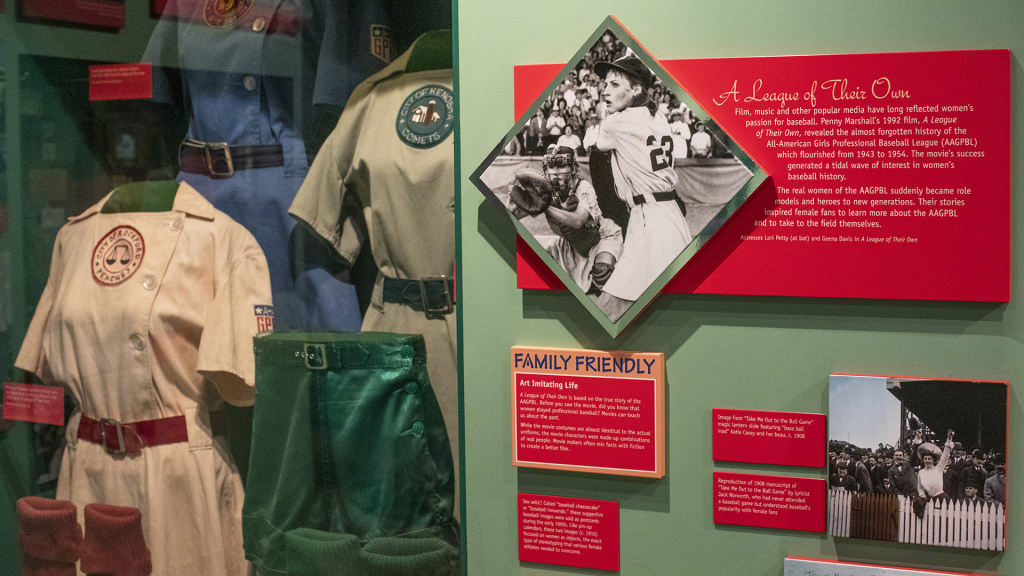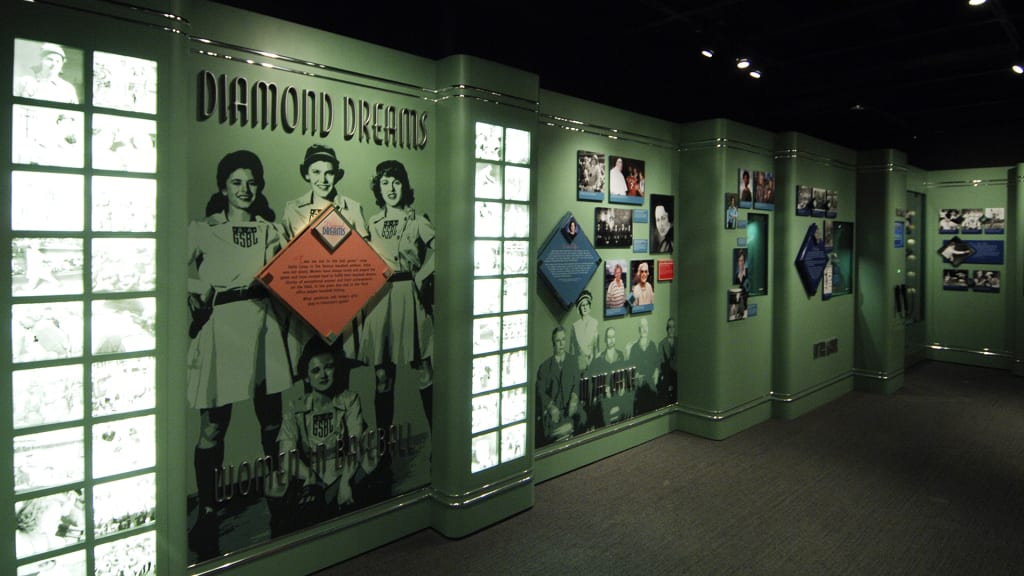
When the Women in Baseball exhibit opened at the National Baseball Hall of Fame and Museum in 1988, it consisted of a single glass case with artifacts. At that time, this glass case was the extent to which women’s contribution to baseball history had been immortalized in a museum.
Since then, the role of women in baseball has dramatically expanded, and the exhibit -- which is now called “Diamond Dreams” -- has grown along with it. Today, visitors in Cooperstown can walk through a vast timeline of women in baseball spanning nearly 80 years of history, from the All-American Girls Professional Baseball League to present-day coaches, players and executives.
“This is a prime example of what a museum should do. We did this thing, and it made a difference,” Ted Spencer, the chief curator of the Hall of Fame’s original Women in Baseball exhibit, said in a recent phone call with MLB.com. “Women now realize that they have a piece of the ownership of the game.”
The idea for a Women in Baseball display began in the mid-1980s after a meeting in the Hall of Fame library between Spencer and Sharon Roepke, a historian who had organized the AAGPBL Players Association and whose aunt played in the league. She gave Spencer a pamphlet she had written on the league’s history and a set of AAGPBL baseball cards.
As he read through the cards and learned about the women in the league, he realized that he had a unique connection to the AAGPBL -- one of his childhood teachers was Mary Pratt, a pitcher for the Rockford Peaches and Kenosha Comets from 1943-47. Spencer and Bill Guilfoile, then the Hall of Fame’s public relations director, soon had an idea for a groundbreaking exhibit that honored the AAGPBL and other women integral to baseball history. At the time, there was no blueprint for such an exhibit.
“We were under no pressure to do an exhibit [on women in baseball]. Nobody has done that. It was on nobody's radar,” said Spencer.
After an interview with Spencer ran in the Los Angeles Times in early 1987 stating the Hall’s interest in creating a Women in Baseball exhibit, letters began arriving from AAGPBL alumni, including former pitcher Dottie Collins. She offered to help supply some artifacts for an exhibit via the Northern Indiana Historical Society, and the gears were set in motion. Twenty months later, the AAGPBL reunited in Cooperstown for the unveiling and Spencer and Collins had formed what became a lifelong friendship, all thanks to this new Women in Baseball exhibit.
“It basically, in many, many ways, revolutionized the story of women in baseball,” John Odell, who has worked as a curator at the Hall of Fame since 1999, said in a phone call with MLB.com. “It was the first time that this story had been treated in any way, shape or form in a museum and treated with seriousness, sensitivity and respect.”
The exhibit was a hit from the day it opened on Nov. 5, 1988. In its first iteration, it contained, among other things, AAGPBL uniforms, gloves, a championship trophy, a Player of the Year plaque awarded to Dottie Kamenshek and Pratt’s suitcase from her playing days -- which is still in the exhibit today. It struck an understandably emotional chord with the AAGPBL women it commemorated, but it also attracted the attention of director and baseball fan Penny Marshall, who attended the opening.
Just as women in baseball were making their way into Cooperstown, they were also making their way into Hollywood. In 1987, Kelly Candaele (whose mother, Helen, had played in the AAGPBL) and Kim Wilson produced a 27-minute documentary about the AAGPBL. Marshall had already been in talks with Candaele and Wilson about turning this documentary into a feature film in ‘88, but weaving in the Hall of Fame’s Women in Baseball exhibit added a perfect framework for what became a beloved story.
“I honestly do think that the element of being able to situate this game not just in Chicago and in the Midwest, but in Cooperstown, that was one of the things that was just so instrumental, with Penny coming to Cooperstown and watching the actual exhibit opening take place,” Odell said.
“A League Of Their Own” came out in 1992 and quickly became a baseball classic, and Marshall’s relationship with the Hall of Fame continued -- long after the film was released. Over the last few decades of her life, Marshall -- who passed away in 2018 -- donated much of her extensive baseball collection to Cooperstown, which included movie artifacts and other “decorative arts” like baseball-themed napkin rings and clocks.
Marshall’s collection also included an interesting connection to Bud Fowler, who will be inducted into the Hall of Fame on July 24. Fowler, who is regarded as the first Black professional baseball player and played from 1878 to 1895, was also an avid musician. In 1909, Fowler wrote a song called “The Royal Giants” in honor of his friends Grant “Home Run” Johnson and Bill Monroe, who both played for the Brooklyn Royal Giants of the Negro Leagues at that time.
Somewhere along the line while growing her baseball collection, Marshall purchased the sheet music to Fowler’s “The Royal Giants.” This sheet music was included in her donations to the Hall of Fame, and it will be on display in Fowler’s inductee case in Cooperstown later this year.
“[The sheet music] shows how widely Penny Marshall was casting her collecting net, and that she saw value in a lot of different things,” Odell said.
Between 2004 and 2006, the Hall of Fame gave the Women in Baseball exhibit its first major facelift. Odell was the lead curator for these renovations, which involved expanding the exhibit, grouping its artifacts and displays into themes and renaming it “Diamond Dreams.”
For years, Hall of Fame visitors had been asking about what happened to “the old Women in Baseball exhibit” from the movie scene when the AAGPBL women walk through the Hall and see their uniforms on display. In fact, this “old exhibit” had never existed. When “A League Of Their Own” was filmed in the early 1990s, the Hall of Fame converted its fine art gallery -- a room off the main entrance that today houses restrooms -- into a Women in Baseball exhibit suitable for a Hollywood recreation of the original 1988 exhibit opening.
When filming in Cooperstown was completed, the “exhibit” immortalized in the movie was dismantled. By the mid-2000s, the Hall of Fame staff decided it was time to add some of that Hollywood magic back.
“The original exhibit was sort of just a display, without much theme or narrative thread,” Odell said. “We wanted to create a feeling that when you got there, you knew you're there.”
In Diamond Dreams -- which was given a retro, art deco design to honor the mid-century heyday of women’s baseball -- there were now distinct sections devoted to celebrating women from all walks of baseball history, not just the AAGPBL. Want to learn about women who sat in the owner’s box? Visitors could read all about Helene Britton, the first woman to own an MLB team, and Effa Manley, co-owner and general manager of the Newark Eagles and the only woman enshrined in the Hall of Fame. Curious to know more about women in the front office? There was a new section discussing Janet Marie Smith, a trailblazing baseball executive and architect.
From broadcasters and PA announcers to reporters, organists and women who played on all-men’s teams, Diamond Dreams now encompassed every aspect of the rich history of women in baseball.

Today, with Diamond Dreams in its fourth decade, women are breaking new ground in baseball every season. The Hall of Fame is regularly updating its exhibits as new women rewrite chapters of baseball history. Curators are actively collecting artifacts -- caps, jerseys, you name it -- from trailblazing women like Giants coach Alyssa Nakken, adding them to the Hall’s collection and swiftly integrating them into museum displays.
However, artifacts from historic women in baseball don’t just reside in Diamond Dreams anymore -- they’re all over the museum, from the “Today’s Game” cases to the team lockers. Nearly 80 years after the AAGPBL first took the field, the Hall of Fame now recognizes women's baseball artifacts as part of the broader scope of baseball history.
“We can incorporate the story of women becoming a more visible part of the baseball world, and also tell the story of Diamond Dreams, but we don’t want to ghetto-ize the story by only putting it into one spot,” Odell said. “We want to make sure that these artifacts are presented equally and on the same footing as the men’s artifacts are being presented.”
Today, only a handful of the women who played in the AAGPBL are still alive, including Jean Faut, the only professional baseball player to throw two perfect games, and Betsy Jochum, the only living AAGPBL player who played in the league’s inaugural 1943 season. But thanks to the Hall of Fame’s Women in Baseball exhibit, even after all of these women have passed on, they will live forever in Cooperstown. Thanks to their efforts, thousands of women today are living out their own diamond dreams.
“We are living in the beginnings of baseball finally figuring out that women love baseball, they’ve always loved baseball, and they’re smart enough to contribute to the damn game,” Odell said.
“We’re at the beginning of a new wide-ranged role for women in the game that I don’t think is going to end.”
